
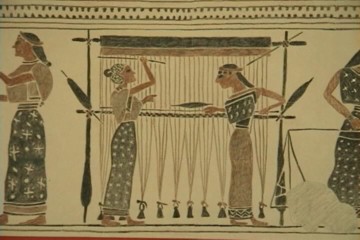 In the first part of this long post, I described the long process involved in turning any type of fiber (wool, flax, silk, cashmere, cotton) into strands for weaving, to produce cloth, and how labour intensive it was in the past, when machines didn’t do all the work for us.
In the first part of this long post, I described the long process involved in turning any type of fiber (wool, flax, silk, cashmere, cotton) into strands for weaving, to produce cloth, and how labour intensive it was in the past, when machines didn’t do all the work for us.
All That Was A Woman’s Responsibility
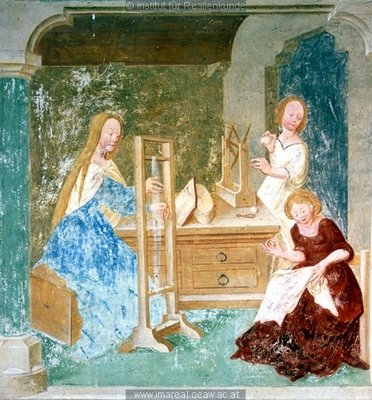
The process of making cloth is an exhausting list, just reading it.
Add in the fact that everything was hand-whatever’d throughout most of history, and the labor involved in, say, making a man’s shirt looks overwhelming.
Yet, that was what the woman of the family faced, every single day. She took fibers from raw to wearable garments, and not just her husband’s shirts and tunics…everything in the home was handmade by her.
Look at the list of items you spotted in the area where you are right now, that I asked you to identify in part one of this post. The woman was responsible for all the historical versions of those times…and more.
Consider something as simple as menstruation. Historically, women used pads made from cloth, held against their bodies with garters…and they had to make all of them.
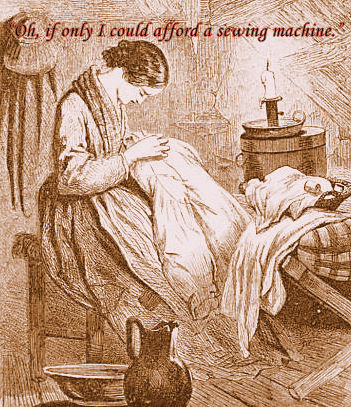 Anything needed to store food or process it (for example, straining cloths), the woman spun, wove and sewed.
Anything needed to store food or process it (for example, straining cloths), the woman spun, wove and sewed.
Even just supplying every item of clothing needed by a family would have been a challenge. As houses were unheated, layers of clothing were the only way to stay warm in winter, so even more garments were required.
You can understand why for thousands of years, comfort-creating items like cushions under your rear and behind your back, and rugs underfoot to keep your feet warm were considered extravagant indulgences. There simply wasn’t time to make them!
It’s also why only royalty and the upper class got to wear lace and brocade – they were the only people who could afford to pay for the time-consuming effort involved in their making.
Thumbelina – All in One Day
I read a Thumbelina style story when I was a child about a two-inch high woman who falls in love with a prince. The prince has seven brothers, and all eight sons have been sent out in the world to find an accomplished woman to marry.
Each woman is tested to measure her accomplishments. She must make a man’s shirt in one day—taking the raw findings, spinning and weaving and sewing the shirt before sundown.
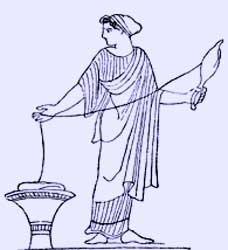 The prince supplies the tiny woman with a tiny spindle, loom and needles, and she of course is the only one to complete the test. The prince promptly asks her to marry him, at which point, the spell is broken and she becomes a full-sized woman. [And if you recognize the story or know the name of it, please share! This is the sum total of what I remember about it!]
The prince supplies the tiny woman with a tiny spindle, loom and needles, and she of course is the only one to complete the test. The prince promptly asks her to marry him, at which point, the spell is broken and she becomes a full-sized woman. [And if you recognize the story or know the name of it, please share! This is the sum total of what I remember about it!]
Magic aside, I was always curious about why making a shirt in one day would be considered the high-water mark of an accomplished woman.
My research in the last few months for various historical novels has given me a glimpse of the answer, which I’ve tried to lay out here. I suspect it would be near impossible for a woman to make a man’s shirt in one day. The weaving alone would eat up a single day, even using a more modern loom!
Yet this was the challenge facing women in the past. They had to be at least competent at every step involved in making cloth, because her family depended upon it.
The Highly Skilled Won Royal Favor
 Some women became far more than competent in one or more of the stages of making cloth. If, for example, a woman was very good at spinning the finest of fibers, which could make very soft, even and fine cloth, her skills would be in demand and, often, be brought to the attention of nobles and the rich, who could afford to pay her (or, in earlier times, simply dragoon her) to use her skills to make cloth for them.
Some women became far more than competent in one or more of the stages of making cloth. If, for example, a woman was very good at spinning the finest of fibers, which could make very soft, even and fine cloth, her skills would be in demand and, often, be brought to the attention of nobles and the rich, who could afford to pay her (or, in earlier times, simply dragoon her) to use her skills to make cloth for them.
Sometimes, women would figure out a different way to spin or dye or weave cloth, or sew garments, and a new fashion or a new type of cloth would be invented. The craft would pass on to other women in the area, and sometimes further on.
Bruges lace, Harris Tweed, Scottish Plaid, silk, denim (from De Nimes) are all textiles that originated in geographic locations.
But Every Woman Was Expected To Do It
Even if a woman had two left hands and no interest in the making of cloth, she had no choice. The comfort and health of the family depended upon her industry.
While the husband hunted, gathered food and wood, and made/repaired their shelter and tools, and (occasionally) defended them, the woman took care of everything else, including the making of cloth.
If she was particularly bad at these skills, the family suffered.
Industrialization Put Women In Factories, Instead
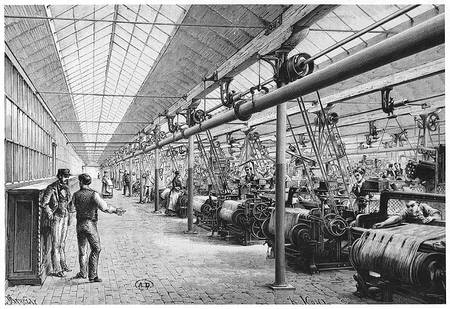
In the mid-29th century, steam and mechanization created industries that could produce better quality cloth more quickly and cheaply than women could make in the home. Those factories, though, required labor to run them and woman with lower family incomes were forced to work in the factories, instead.
The transition was one of centralization and specialization. Women no longer had to make cloth from scratch, for they could buy what they needed, ready-made.
However, it required a higher income to purchase what they did not make, which began a steady progress across the next two centuries to today’s world where very few families can afford to have the wife and mother stay at home. She must bring in a second income in order to acquire the most basic needs—food, shelter and a degree of comfort.
Usually, the more specialized a woman’s skills, the higher her income, which is the complete reverse of a woman’s role in ancient and medieval times, when she was rewarded (with a healthy family) and admired (by her husband and her village) for the breadth of her skills.
What Else Did Women Have To Do?
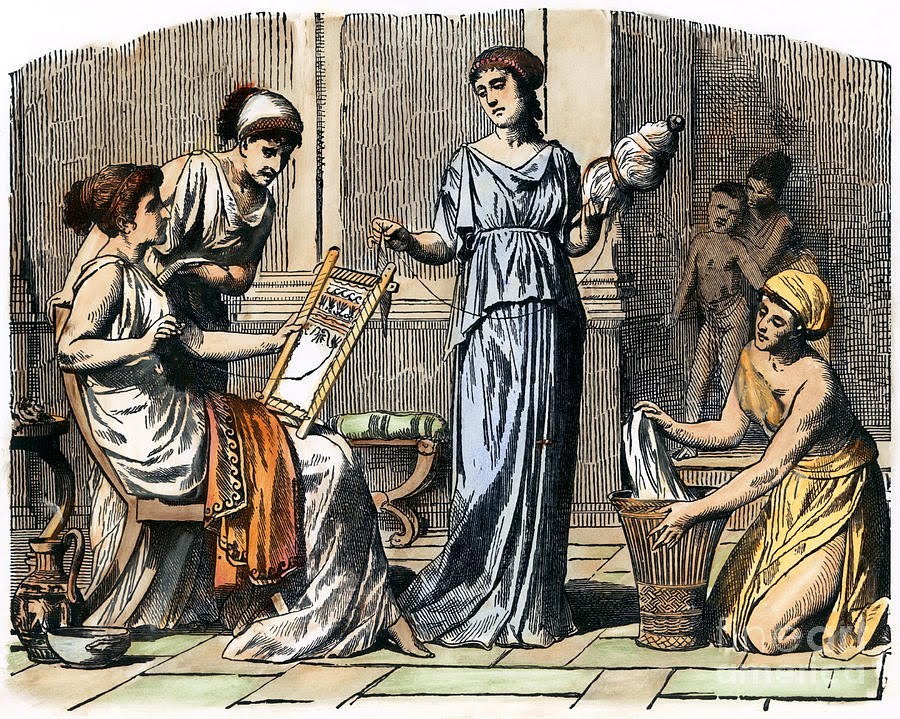 Oh, many, many things! Because I have been so immersed in research for the last little while, I’ve developed quite a list. I’ll write up a few more of these posts in the future.
Oh, many, many things! Because I have been so immersed in research for the last little while, I’ve developed quite a list. I’ll write up a few more of these posts in the future.
Cheers,
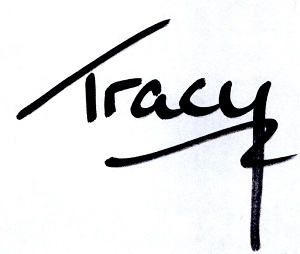
.
Get the news that no one else does. Sign up for my newsletter.
For a short while, you get a bundle of ebooks, free, when you sign up, as a Starter Library. Details here.